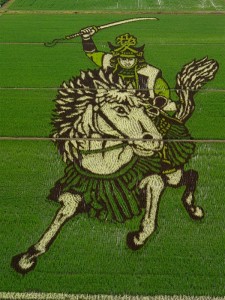“Crop Art” from Japan:

Bobby Jones forwarded me an email with Japanese rice paddy “crop art” that prompted me to do a little bit of searching on the internet.

There has been quite a bit of buzz about “sustainable living” in recent years, but most of the buzz has been promoting somewhat unrealistic, pie-in-the-sky, perspectives. Everybody wants to talk about sustainable living, but nobody wants to walk the walk.
But here is a glimpse of what it could be like. People living in towns…not alone in a isolated house in the middle of a prairie… but close to, maybe even engaged in, and involved with the agriculture that supplies their food.
Inakadate Village, a Japanese town of about 8700 people, has gained quite a bit of notoriety by creating “crop art” by planting rice fields with strategically placed rice plants of different colors. You have to climb to the top of the tower of town’s village office, (about 22 meters high) that over-looks the fields to get the images to appear in the right perspective. And in the perfect blending of ages-old agriculture and state-of-the-art modernity, computers are used to calculate where the different varieties of rice plants have to be placed to produce a correctly proportioned image when viewed from the top of the tower.
Cooperation plays a large part too. Apparently the land owners of rice paddies had to agree to work together to get a field big enough for the larger images, the village office workers spent a significant amount of personal time planning the image, and as many as 700 volunteers helped with the actual planting.
The result is an iconic example of what true, sustainable living could be like. It is the perfect blending of agriculture, technology, community, and art.
I don’t know how commercially viable the rice paddies of Inakadate Village are, but I don’t see why agriculture intermixed with residential areas couldn’t be viable. It would be environmentally friendly, would provide fresher, locally grown produce, and would give people living in high population density areas a little more experience with the “real world” of earth, plants, and the cycle of the earth’s seasons that we are all really a part of.
One thing is for sure: We will have to reduce property taxes to zero or near zero if we are ever to have farms co-existing with communities. As it is now, the money-making racquet of our local governments driving up land prices by “eminent domain” powered redevelopment in order to raise the property values to generate higher property tax revenues will have to end. A farm that tried to exist today in the midst of big cities would find their annual property tax bill a bank-breaker.
You can search Google for “Inakadate rice paddy art” for more images and information, and here is a link to an article by Yoko Hani in The Japan Times.